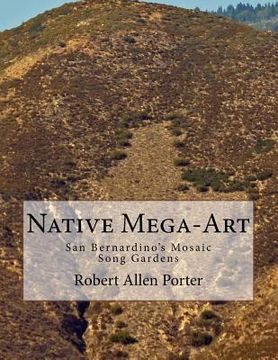Reseña del libro "Native Mega-Art: San Bernardino's Mosaic Song Gardens"
Explanations of the Native Mega-Art When explaining the native mega-art it is necessary to understand that this is the remanence of a significant southern California culture, prior to European influence. This art can be the common link amongst the First People's clans, showing that they shared a common culture based on songs. Songs are the oral link that all First People's had with the Creators, ancestors, each other, and the natural world around them. Most cultural concepts were delivered through ritual song and dance. These clans were thought to be primarily oral teachers of culture and written communication didn't exist. The rock art left by past inhabitants at places mentioned even in their songs, anthropologically still have varied explanations of why they exist. The First People's considered this art sacred and most hesitantly shared small details or even had no information to offer the early anthropologists. Theories on the art range from marking territory and resources, to abstract shamanistic thought. If you add anthropological ignorance with First People's secrecy of sacred knowledge, the end result was overlooking one of the largest most important cultural discoveries in human civilization. First People's mega-art is meant to be read and taught by a trained leader or shaman, to others raised in their common culture. Explaining some of theories of my interpretations of the songs, writings, or mega-glyphic art will be the focus of this book. Then using outlined photographs the reader can recreate the vision-questing observation style and focal placement, used long ago to read these mounded and pixelated songs on the hills. By presenting the ancient images significance to the people in southern California and their common creation history, I hope to show its usefulness. This mixing of song, art, and native history should alter your view of the mountains and how the local First People's utilized them. Theoretically, between the year 0 to 1800 C.E. or longer, the local natives were in full control of the North American Southwest. These modern humans had the same mental and physical skills as us and had developed a superior understanding of this resource rich area. Westerners believe in the concept of the wild, but is this a reality for peoples that have lived in their homeland for so long? I mean to give credit, where the credit is due. In my opinion this was not the wild for the local First People's. Southern California was the spot they were created, loved, sang, danced, and survived for many thousands of years near the cold and hot springs. Could local peoples, in one of the good climatic intervals, create a civilization here using and trading all the incredible resources available? The answer I hope to prove is yes they did, and now we must open our eyes to see the ancient songs and culture left to us. This native art could have represented many things including creation history, astrological signs, calendar ritual timing, bird/sheep cultural songs, and other things related to local cultural thought. In A.L. Kroeber's book written in 1925, Handbook of the Indians of California: Chapter 46; The Luiseño; Elements Of Civilizations; Shamanism; pg. 681, he mentions an old Luiseño story of shaman receiving songs from a rock or the mountain. "There is, it is true, one Luiseño statement to the effect that the shamans dream of "a rock, a mountain, a person, or something similar" and receive songs from this object of their dream. But this reference is too vague to count for much. The mountain or person might be mythological, as among the Mohave; that is, an ancient bestowing divinity rather than a present and controllable spirit."

